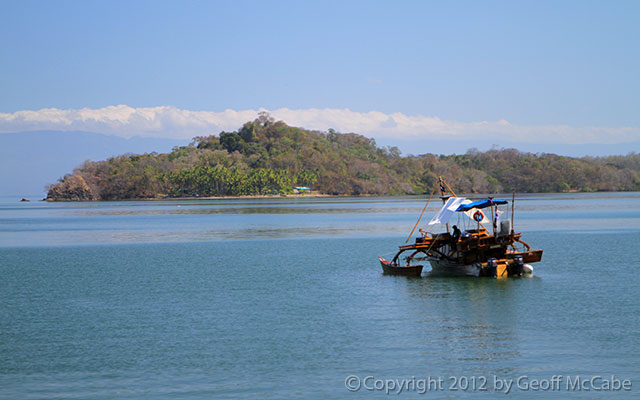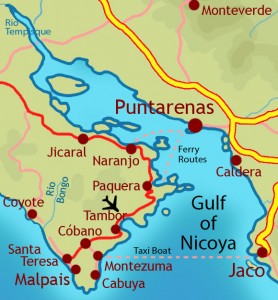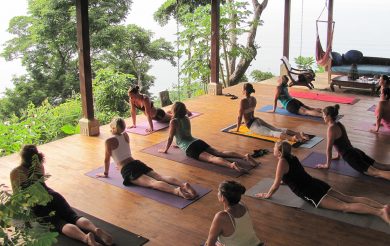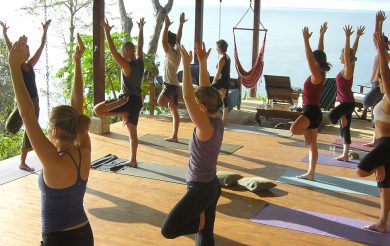- Home
- Accommodation
- Activities
- Area Info
- Maps
- Photo Galleries
- Real Estate
- Travel
Gulf of Nicoya

The Gulf of Nicoya (Gulfo de Nicoya in Spanish) is one of Costa Rica’s two large gulfs on the pacific side of the country. It’s ringed by a series of popular beach towns such as Montezuma, Cabuya, Tambor, Paquera, Jaco, and the city of Puntarenas.
Threats to the Gulf of Nicoya
Human-originated threats to the Gulf have been taking their toll on the fish species and biodiversity. Whales and dolphins, which used to be much more common, and would even come to have babies here, are much more rare than before. Highly sensitive animals such as seahorses, are becoming nearly extinct in areas such as Montezuma and the Tortuga Islands. Even professional dive instructors who are in the water almost daily, report they may spot a seahorse only once every couple of years. It seems a miracle that such rare underwater species can even find each other to breed!
Runoff from various rivers, such as the Rio Tarcoles, which brings mountains of trash floating into the gulf, is a big and obvious problem, since anyone who ventures onto a boat or beach can see the garbage. Less obvious threats come from the increased quantities of organic material that comes down into the rivers due to soil erosion, which is primarily caused by cattle farming and real estate development. In many of the cattle farming areas, it’s easy to see the erosion that results when there are no tree roots holding the topsoil.
Another threat is agricultural pollution. Chemical nitrogen fertilizers run into the gulf, partially contributing to toxic blooms of algae known as “red tides” This algae uses up the oxygen in the water and suffocates water species, and can be poisonous to everything in the water, including people. Due also to global warming of the oceans, red tides are become more common and in the gulf are occurring nearly every dry season when the water is at its warmest.
Untreated septic waste is a problem in nearly every beachfront town and city in the area, because of laziness and corruption in the governmental bodies that should be making this a priority to protect tourism. Luckily, the toxic bacteria such as ecoli that comes from untreated waste in the ocean only lives about 24 hours, so it doesn’t spread far from the town centers where it originates.
 Pesticides and other poisons are purposely and consistently used in agriculture and industry, and unfortunately Costa Rica was recently reported to have use more toxic pesticides, per acre of crops, than any other country in the world, some of which inevitably end up in the sea, becoming part of the food chain. Read more about that here: Costa Rica is #1 in pesticide use and here: Costa-Rica-pesticide-use-highest-in-world. The good news is that Costa Rica’s organic farming movement is expanding very rapidly, and awareness of the problem is growing, but as with everything else, there are a bunch of wealthy interests who will ignore the common good so that they can afford bragging rights as to the size of their yachts and number of vacation villas around the world.
Pesticides and other poisons are purposely and consistently used in agriculture and industry, and unfortunately Costa Rica was recently reported to have use more toxic pesticides, per acre of crops, than any other country in the world, some of which inevitably end up in the sea, becoming part of the food chain. Read more about that here: Costa Rica is #1 in pesticide use and here: Costa-Rica-pesticide-use-highest-in-world. The good news is that Costa Rica’s organic farming movement is expanding very rapidly, and awareness of the problem is growing, but as with everything else, there are a bunch of wealthy interests who will ignore the common good so that they can afford bragging rights as to the size of their yachts and number of vacation villas around the world.
Overfishing the Gulf of Nicoya
For years, the Gulf of Nicoya has been over-fished, leading to depleted marine life, but the recent news has been more positive as the Costa Rican government, along with NGOs has started some surveillance and education programs to attempt to keep the gulf’s fish stocks from collapsing. An estimated 4000 fishermen are working in these waters, and as is usual with such things, left on their own they will destroy all the fish and ruin their own livelihood. This phenomenon is known as “The tragedy of the commons” whereby a resource shared “in common” will inevitably be destroyed by competing interests, none of which want to limit their own consumption and thus take on a competitive disadvantage in the market.
The best solution is local government laws that are enforced equally and transparently, to create a level playing field within which the various parties can compete, while maintaining a sustainable system. In the case of fisheries, the easiest way to accomplish this is to simply have a certain percentage of NO FISHING ZONES where the fish can live and reproduce freely. Yet, even these simple and obvious solutions are difficult to accomplish due to human greed and the power of big money, politics and corruption in the fishing industry. The reality is that everyone wants the same thing, which is a sustainable fishery that works for fishermen and their families, sportfishing, and eco-tourism, but there are always a few powerful and manipulative men involved who are only interested in amassing personal wealth, power, and “shareholder value”. Inevitably, not much gets accomplished until the system is nearly broken. Luckily for the Gulf of Nicoya, the people and politicians of Costa Rica are relatively eco-minded and proud of their natural heritage, and many people are working hard to protect the country’s natural resources and ecosystems. While many other countries in Central America are rapidly ruining themselves, there is much optimism that Costa Rica will get this right before it’s too late.
References
Great Stuff

Clandestina Restaurant
My new favorite restaurant, Clandestina is not to be missed by food lovers staying anywhere near to Montezuma. Established in March 2015, Clandestina is the new kid on the block. The Oregon/Tico collaboration is a winner among locals and travelers alike, with artisan craft beers, made onsite by Butterfly Brewing Co. and delicious, exciting […]











